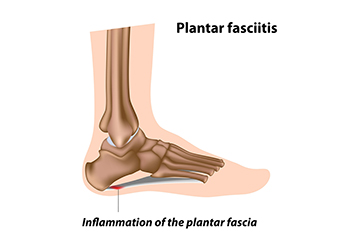Definition and Risk Factors Explored for Plantar Fasciitis
Tuesday, 19 December 2023 00:00
Plantar fasciitis, a prevalent foot condition, unfolds as inflammation of the plantar fascia, which is the thick band of tissue connecting the heel bone to the toes. This inflammation results in stabbing pain, typically most pronounced during the first steps in the morning or after periods of inactivity. The plantar fascia plays an important role in supporting the foot's arch and absorbing shock during walking. Several risk factors contribute to the development of plantar fasciitis. Prolonged periods of standing or walking on hard surfaces can strain the plantar fascia, increasing susceptibility. Individuals with high arches or flat feet may experience altered weight distribution, intensifying stress on the foot's support structure. Additionally, having tight calf muscles and Achilles tendons may also heighten the risk, limiting ankle flexibility. Understanding the definition and associated risk factors of plantar fasciitis is vital for proactive management. If you have heel pain, it is strongly suggested that you seek the counsel of a podiatrist who can offer treatment options for this painful condition.
Plantar fasciitis is a common foot condition that is often caused by a strain injury. If you are experiencing heel pain or symptoms of plantar fasciitis, contact John Killough, DPM from Regional Foot Center. Our doctor can provide the care you need to keep you pain-free and on your feet.
What Is Plantar Fasciitis?
Plantar fasciitis is one of the most common causes of heel pain. The plantar fascia is a ligament that connects your heel to the front of your foot. When this ligament becomes inflamed, plantar fasciitis is the result. If you have plantar fasciitis you will have a stabbing pain that usually occurs with your first steps in the morning. As the day progresses and you walk around more, this pain will start to disappear, but it will return after long periods of standing or sitting.
What Causes Plantar Fasciitis?
- Excessive running
- Having high arches in your feet
- Other foot issues such as flat feet
- Pregnancy (due to the sudden weight gain)
- Being on your feet very often
There are some risk factors that may make you more likely to develop plantar fasciitis compared to others. The condition most commonly affects adults between the ages of 40 and 60. It also tends to affect people who are obese because the extra pounds result in extra stress being placed on the plantar fascia.
Prevention
- Take good care of your feet – Wear shoes that have good arch support and heel cushioning.
- Maintain a healthy weight
- If you are a runner, alternate running with other sports that won’t cause heel pain
There are a variety of treatment options available for plantar fasciitis along with the pain that accompanies it. Additionally, physical therapy is a very important component in the treatment process. It is important that you meet with your podiatrist to determine which treatment option is best for you.
If you have any questions, please feel free to contact our offices located in Charleston and Effingham, IL . We offer the newest diagnostic and treatment technologies for all your foot care needs.






